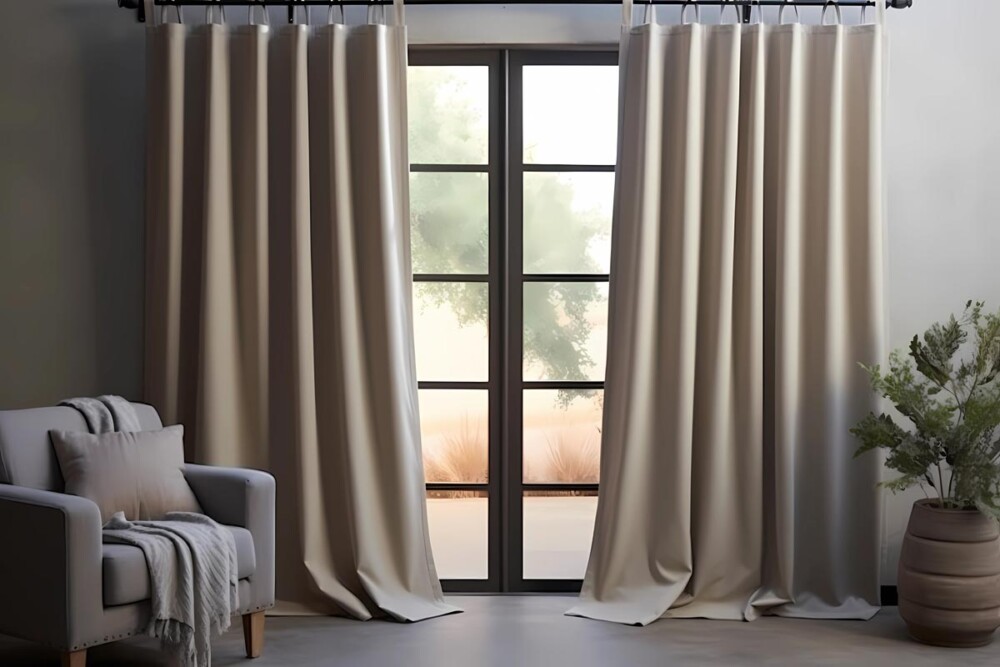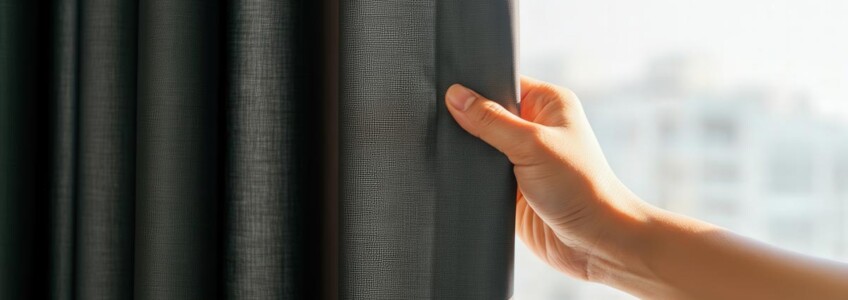Blackout curtains are one of the most effective solutions for improving the visual and thermal comfort of rooms, especially when you want to create a welcoming space, protected from light and capable of guaranteeing privacy at any time of day. In recent years, blackout fabrics have evolved from simple technical supports to true furnishing elements capable of interacting with the style of the home. A careful choice of material, texture and finishes allows not only to control the natural lighting, but also to add character inside bedrooms, living rooms, home cinema rooms or offices.
Manifattura Foderami Cimmino guides us in the discovery of blackout fabrics by explaining well what really distinguishes a blackout fabric from a filter fabric, what technical characteristics to evaluate, how to take precise measurements and what measures to adopt to integrate blackout curtains into a balanced furniture project.

What blackout curtains are and why they are useful in the home
When talking about blackout curtains, we are referring to upholstery fabrics and drapes designed to significantly reduce the passage of natural light, creating more collected and protected environments. Unlike filter materials, which dim the brightness while still allowing a glimpse of the outside, blackout fabrics have a more compact structure or are equipped with specific technical treatments capable of blocking a much greater amount of light.
The choice of a blackout curtain is recommended in various domestic and professional situations. In the bedroom it helps to create optimum conditions for rest, especially if the exposure is to the east or if the area is particularly illuminated by external street lamps. In the living room, it allows you to avoid reflections on TV screens or shiny surfaces, improving visual quality. In work environments, it allows you to adjust the lighting for activities that require concentration or the use of monitors.
In addition to brightness control, blackout curtains offer an additional advantage: they contribute to thermal insulation. Some fabrics have a coating capable of limiting heat loss in the cold months and reducing summer overheating, providing a more stable and comfortable environment. Privacy also increases, as from the outside you cannot glimpse the inside, maintaining discretion at all times of the day.
Differences between filter, semi-darkening and blackout curtains
The main difference lies in the amount of light each fabric lets through. Filter materials dim the brightness without creating darkness, while semi-darkeners offer an intermediate level, perfect for environments where you want privacy without sacrificing natural light. Blackout fabrics, on the other hand, provide much more incisive control, creating a more intimate atmosphere. They are the most functional choice for bedrooms or rooms exposed to direct light.
Benefits of blackout curtains: darkness, privacy and thermal comfort
A quality blackout fabric offers a triple advantage: reduced light passage, better privacy and greater thermal comfort. Darkening makes rest easier and improves the visual rendering of screens. Thermal insulation comes from the denser structure or any treatments that limit heat loss and summer overheating. Combining these factors results in a more functional, comfortable and balanced environment in the different seasons.

Blackout fabrics: technical features and how to choose the right material
The choice of fabric is the element that most affects the final yield of blackout curtains. Each material has particular characteristics of texture, weight and composition, which determine its effectiveness in darkening but also its aesthetics and fall. Popular fabrics include polyester, synthetic blends, jacquard, and technical materials with specific coatings. The most relevant parameter remains density: a greater compactness of the texture allows for a greater percentage of light to be blocked.
The weight per square meter of the fabric is also indicative: heavier fabrics usually offer a more incisive darkening and guarantee an elegant fall, perfect for modern or classic environments. Conversely, lighter materials can be ideal in contexts where a clean but still functional tent design is preferred.
Finally, the surface can be smooth, embossed or with elaborate textures, capable of enhancing the room and harmonizing with other textile elements present. Carefully evaluating the finish allows you to obtain a result that is not only high-performance but also aesthetically consistent.
Plot, weight and composition of blackout fabrics
The compactness of the weft and the weight of the fabric are fundamental indicators of the level of darkening. Densely structured materials block light more effectively, while technical coatings, often applied on the back, enhance insulating properties. The composition can range from polyester to blends with synthetic fibers. Each combination offers a different balance between functionality and aesthetic rendering, allowing you to choose the solution that best suits the style of the house.
How to recognize thermal fabrics and blackout fabrics
Thermal fabrics feature specific treatments that slow the passage of heat, keeping the environment more stable in summer and warmer in winter. Black-out fabrics, on the other hand, guarantee maximum blackout capacity thanks to a multilayer structure or special coatings that prevent light from filtering. Recognizing them is simple: they have a more technical and compact back, often in a uniform shade. Ideal for those who want total darkness.
Tessuto Dark Ignifugo
Tessuto Dark Ignifugo is a technical solution designed for all environments where safety and light control are priorities. Made of 100% polyester, it combines fireproof and blackout properties, making it ideal for blackout curtain packaging, stage curtains and, more generally, for any project that requires materials capable of preventing or limiting combustion.

The non-stretch structure and generous height of 300 cm offer great versatility during the packaging phase, while the weight of 750 g/MTL (equal to 250 g/m²) guarantees consistency and a uniform drop, essential for obtaining compact blackout panels free of transparency. The solid finish also allows it to be easily inserted into different aesthetic contexts, from the theatre to professional spaces, up to domestic environments that require total darkening.
A reliable, functional technical fabric designed to meet specific safety and light performance needs.
Colors and finishes: how to combine blackout curtains with furniture
Color affects both the aesthetic rendering and the perceived effect of the room. Dark shades intensify darkening, while light colors maintain a bright appearance even with technical fabrics. The finishes can be smooth, matte or slightly textured, perfect for integrating into modern, Nordic or classic interiors. Pairing the curtain with other textile elements, such as rugs, cushions, or armchair covers, creates visual harmony and a touch of continuity in the space.

How to Measure and Install Blackout Curtains Correctly
Measuring the window correctly is one of the most important aspects to obtain an effective and visually orderly blackout curtain. Size influences tissue drop, coverage, and darkening efficiency. Accurate measurement also ensures greater aesthetic uniformity, especially when custom-made curtains are desired that are perfectly proportioned to the frame.
The mounting system plays an equally important role. The choice between stick, track, roller or package depends on the style of the house, the desired functionality and the available space. Each solution offers different advantages in terms of practicality, aesthetic rendering and light management. For example, a blackout roller blind is ideal for minimal and modern environments, while traditional track blinds ensure a softer and more decorative fall.
In the presence of special fixtures such as attics or French windows, it is necessary to evaluate dedicated systems that allow the curtains to remain stable and close-fitting, avoiding lateral or upper light filtering. Tailored solutions address these critical issues, delivering flawless accuracy and performance.
How to Measure Windows and French Doors for Blackout Curtains
The measurement must consider both width and height, including lateral coverage margins to avoid light infiltration. For curtains installed on the wall or ceiling, it is useful to increase the width by a few centimeters to enhance the blackout effect. It is always advisable to measure in multiple places, as some walls may not be perfectly aligned. Accuracy at this stage ensures a more orderly and functional final result.
Mounting types: stick, track, roller and blackout package
The stick is a versatile and decorative solution, while the track offers a smoother and more orderly flow. Blackout roller blinds are ideal for modern design environments thanks to their clean and compact line.
Blackout solutions for attics, French windows and special fixtures
In the case of attics, French windows or fixed glass it is essential to choose systems that keep the fabric adherent to the frame even during opening. For sloping windows, side guides are needed to prevent light infiltration, while

Blackout curtains and style: how to integrate them into your home design
Integrating blackout curtains into your decor requires a balance between functionality and style. A blackout fabric can become a defining element of the room or a discreet detail that blends into the environment. For modern blackout curtains, neutral colors, such as pearl gray, sand, and dove gray, are highly appreciated, which easily adapt to contemporary palettes. In more classic or decorated spaces, however, jacquard textures and more structured finishes create a sophisticated effect.
Pairing with other fabrics is essential: choosing curtains that match the sofa, bedspread or cushions promotes visual continuity that enhances the entire environment. Length also affects the atmosphere: long curtains that touch the floor create elegance, while shorter ones are perfect for practical environments like kitchens and studios.
The most common mistake is to select a home decor fabric that is too technical in a space where aesthetic continuity is needed or opt for shades that do not interact with furniture and walls. Considering the environment as a whole allows you to choose a blackout curtain that not only works, but that furnishes harmoniously.
Furnishing styles compatible with blackout curtains
Blackout curtains adapt to different styles: in modern contexts they prefer neutral shades and smooth surfaces, while in classic environments richer finishes and decorative details work well. The Nordic style prefers textured fabrics but in light colors, while industrial interiors are combined with dark hues and clean lines. Evaluating the style of the environment helps to select a coherent fabric.
How to match the colors and materials of blackout curtains to the environment
For a harmonious environment, it’s helpful to reflect the hues already present in the room: a light curtain combined with pillows or carpet creates an immediate visual balance. In minimal settings, a curtain with a smooth finish is preferable, while in richer interiors, elaborate textures can be introduced. The goal is to maintain chromatic coherence and continuity.
Mistakes to avoid when choosing blackout curtains
A common mistake is choosing a color that is too dark in a small room, risking weighing down the space. Neglecting length can also compromise the final effect: a curtain that is too short reduces the feeling of harmony. Finally, the use of tissues not suitable for darkening can lead to unwanted light infiltration. A comprehensive assessment avoids these drawbacks.
Choosing blackout curtains means investing in the visual comfort, privacy, and thermal well-being of your home. The variety of curtain fabrics available at Cimmino Shop allows you to combine technical and aesthetic performance, obtaining solutions tailored to each environment and style.

FAQ- Frequently Asked Questions about Blackout Curtains
It depends on the type of fabric you choose. Black-out models provide maximum dimming and almost completely prevent the passage of light. Traditional blackout fabrics block a very high but not necessarily total percentage.
Blackout fabric significantly reduces brightness, while blackout almost completely blocks light thanks to a multilayer structure or specific treatments.
Yes. Many blackout fabrics have thermal properties that help stabilize the internal temperature, limiting summer heat and retaining winter heat.
Black-out fabrics or heavy darkening materials are ideal, as they ensure optimal darkness and a greater feeling of comfort during rest.
Maintenance depends on the fabric. Many models can be hand washed or machine washed at low temperatures, while others require a gentler treatment. It is always advisable to follow the manufacturer’s specific instructions.



